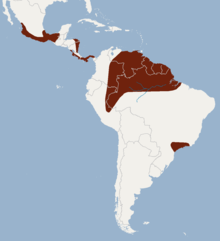Tricolored big-eared bat
The tricolored big-eared bat (Glyphonycteris sylvestris) is a bat species from South and Central America.
| Tricolored big-eared bat | |
|---|---|
| Scientific classification | |
| Kingdom: | Animalia |
| Phylum: | Chordata |
| Class: | Mammalia |
| Order: | Chiroptera |
| Family: | Phyllostomidae |
| Genus: | Glyphonycteris |
| Species: | G. sylvestris |
| Binomial name | |
| Glyphonycteris sylvestris Thomas, 1896 | |
 | |
Description
Individuals weigh 7–11 g (0.25–0.39 oz) and have forearm lengths of 37–42 mm (1.5–1.7 in). The fur on its back is long, woolly, and dark brown. Individual hairs are tricolored, with a dark basal band, lighter middle band, and dark distal band. Its dental formula is 2.1.2.32.1.3.3 for a total of 34 teeth.[2]
Biology and ecology
It is likely insectivorous and frugivorous. It is nocturnal, roosting in sheltered places during the day such as hollow trees and caves. These roosts consist of a colonies of up to 75 individuals.[2]
Range and habitat
It is found in several countries in Central and South America. Its range includes: Bolivia, Brazil, Colombia, Costa Rica, French Guiana, Guyana, Honduras, Mexico, Nicaragua, Panama, Peru, Suriname, Trinidad and Tobago, and Venezuela. It is generally found at elevations lower than 800 m (2,600 ft) above sea level, but has been documented up to 1,100 m (3,600 ft).[1]
Conservation
As of 2018, it is considered a least-concern species by the IUCN. It meets the criteria for this assessment because it has a wide geographic range, its population is presumably large, and it can persist in a variety of habitats.[1]
References
- Solari, S. (2018). "Glyphonycteris sylvestris". The IUCN Red List of Threatened Species. 2018: e.T13384A22123687. doi:10.2305/IUCN.UK.2018-2.RLTS.T13384A22123687.en.
- Medellín, Rodrigo (2014). Ceballos, G. (ed.). Mammals of Mexico. JHU Press. p. 682. ISBN 978-1421408439.
